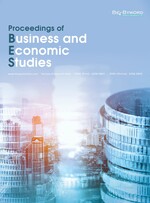Abstract
The development of society and the advancement of science and technology have led to the widespread integration of digital transformation in the field of education. However, the current establishment of green schools faces various challenges, including non-environmental building facilities, high renovation costs, low organizational management efficiency, high energy consumption, outdated office tools, and insufficient environmental awareness among teachers and students. Through thorough research and analysis, it becomes evident that digital technology can play a pivotal role in addressing these challenges and contribute to all aspects of green school establishment. The incorporation of digital thinking concepts is essential for the construction of ecologically civilized campuses and inclusive innovation. The process of digital design and transformation proves instrumental in optimizing both software and hardware facilities within the campus, thereby reducing energy consumption. Simultaneously, comprehensive digital teaching management enhances overall efficiency in management and service delivery. Innovative digital teaching and learning models emerge as transformative tools, providing new avenues to create low-carbon, green classrooms for both teachers and students. By exploring the application of digital transformation in establishing green schools and examining the resulting spillover effects, valuable insights can be gained. These insights, in turn, serve as reference points for building diversified digital technology paths on campus and fostering the creation of green schools.
References
Li Y, Peng J, Luo T, 2022, Digitalization, Spillover Effects, and Corporate Performance. Industrial Technology and Economics, 41(3): 25–33.
Ouyang R, 2022, The Logic, Mechanism, and Path of Digital Economy Promoting Shared Prosperity. Journal of Chang’an University (Social Science Edition), 24(1): 1–15.
Zhang B, Wen Z, Lu Y, et al., 2022, Research on the Digital Transformation of Education to Empower Universities to Build “Double First-Class.” China Informatization, 2022(5): 97–98.
Li Z, Zhang M, 2022, Exploration and Practice of Digital Transformation of University Governance. Office Business, 2022(7): 56–58 + 73.
Ouyang Y, 2022, Exploration of the Digital Transformation of Teaching in Applied Undergraduate Universities. Journal of Liaoning University of Science and Technology, 24(1): 66–68.
Fan X, 2020, Discussion on Digital Transformation Approaches for Application-Oriented Undergraduate Universities. China Educational Technology and Equipment, 2020(10): 56–59.
Fu C, 2021, Digital Transformation of Universities and Educational Brain. China Education Network, 2021(5): 43–44.
Chen Y, Wan X, 2022, Research on the Path of Green School Construction in Higher education institutions Under the Background of the New Era. Science and Education Wenhui, 2022(9): 24–26. https://doi.org/10.16871/j.cnki.kjwh.2022.09.007
Li C, Cheng W, Bai G, et al., 2022, Exploration and Reflection on the Practice of Green School Construction – Taking Beijing Agricultural Vocational College as an Example. Journal of Beijing Agricultural Vocational College, 36(1): 71–76. https://doi.org/10.19444/j.cnki.1671-7252.2022.01.011
Ouyang X, 2021, Research on Green School Construction in Higher education institutions. Popular Standardization, 2021(14): 34–36.
El Hilali W, El Manouar A, 2019, NISS ’19: Proceedings of the 2nd International Conference on Networking, Information Systems & Security, March 27–29, 2019: Towards a Sustainable World Through a SMART Digital Transformation, Rabat, 32, 1–8. https://doi.org/10.1145/3320326.3320364
Wang Z, 2021, Judgment of the Ten Major Trends in the Development of Digital Economy. Communications Enterprise Management, 2021(11): 6–10.
Li C, 2022, Analysis of Similarities and Differences Between the “Green Schools” Created in Higher Vocational Colleges and Other Schools. Environmental Education, 2022(Z1): 64–66.
